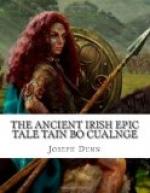One of these many Cattle-preys was the Tain Bo Cualnge,[4] which, there can be little doubt, had behind it no mere myth but some kernel of actual fact. Its historical basis is that a Connacht chieftain and his lady went to war with Ulster about a drove of cattle. The importance of a racial struggle between the north-east province and the remaining four grand provinces of Ireland cannot be ascribed to it. There is, it is true, strong evidence to show that two chief centres, political, if not cultural and national, existed at the time of the Tain in Ireland, Cruachan Ai, near the present Rathcroghan in Connacht, and Emain Macha, the Navan Fort, two miles west of Armagh in Ulster, and it is with the friendly or hostile relations of these two that the Ultonian cycle of tales deals. Ulster, or, more precisely, the eastern portion of the Province, was the scene of all the Cattle-raids, and there is a degree of truth in the couplet,—
“Leinster for breeding,
And Ulster for reaving;
Munster for reading, And Connacht
for thieving.”
But there are no indications of a racial clash or war of tribes. With the exception of the Oghamic writings inscribed on the pillar-stones by Cuchulain, which seem to require interpretation to the men of Connacht by Ulstermen, the description of the warriors mustered by the Connacht warrior queen and those gathered round King Conchobar of Ulster accord quite closely.
The Tain Bo Cualnge is the work not of any one man but of a corporation of artists known as filid. The author of the Tain in its present state, whoever he may have been, was a strong partisan of Ulster and never misses an opportunity of flattering the pride of her chieftains. Later a kind of reaction against the pre-eminence given to Ulster and the glorification of its hero sets in, and a group of stories arises in which the war takes a different end and Cuchulain is shown to disadvantage, finally to fall at the hands of a Munster champion. It is to this southern province that the saga-cycle which followed the Cuchulain at an interval of two hundred years belongs, namely, the Fenian saga,—the saga of Finn son of Cumhall, which still flourishes among the Gaelic speakers of Ireland and Scotland, while the Cuchulain stories have almost died out among them. The mingling of the two sagas is the work of the eighteenth-century Scots Lowlander, James Macpherson.




